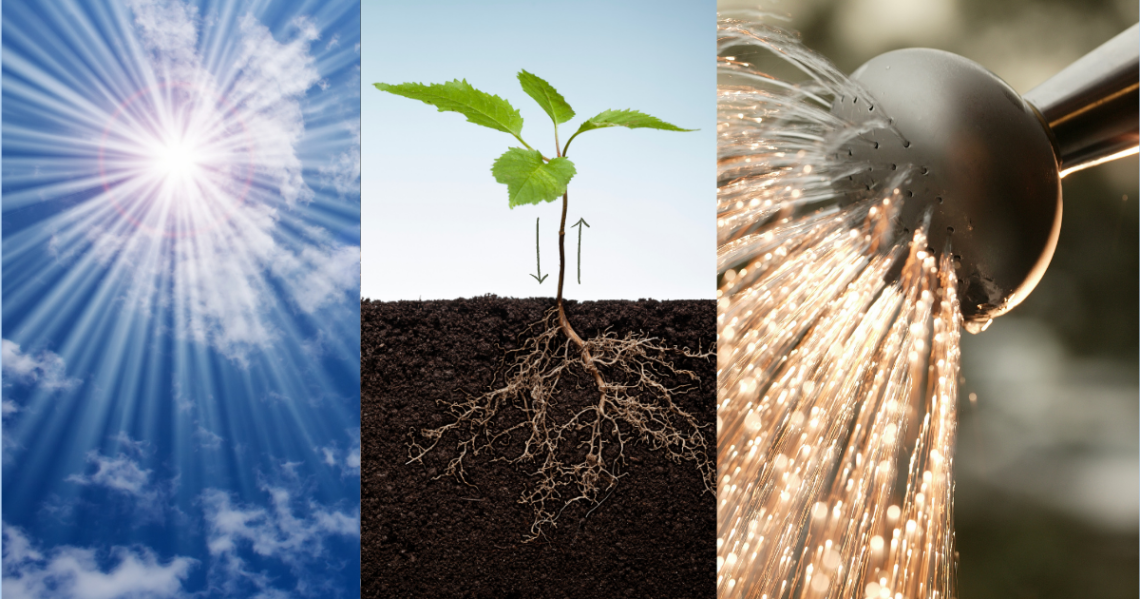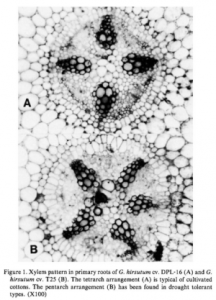There is so much science behind the food we eat, and we’re about to get a little nerdy about some plant science basics! We’ve talked to plant breeders from around the world, Dr. Lee Hickey who works in a plant breeding lab in Queensland, Australia and Dr. Priyanka Gupta who is working on the grasspea in Morocco. Thing is, while plant science as a whole is wildly complicated (there’s a reason Drs. Hickey and Gupta have Ph.D.s), there are some reasonably easy concepts we can all get our head around.
I think a great way to start is to understand how plants move water, nutrients, and energy through themselves. I mean, we’ve all seen how a plant can go from wilted and shriveled to up and perky again after you water it, right? So of course, it’s got to be moving stuff around in there somehow. Plants have vascular sustems just like we do, which is pretty cool when you think about it. Instead of moving blood through arteries and veins, plants move the water and nutrients using their xylem (prounounced zeye-lem) and their phloem (flow-’em – sounds like a football cheer).
Understanding Plant Science & Vascular Systems
Just like for us, the primary components of the vascular system of plants are really the way to transport critical pieces around the plant’s body.
The vascular system on sprouts would be really small and the vascular system of a sequoia would be huge. These systems are designed to transport nutrients, water, and sugars around the plant. The website Biology4Kids.com has a great page (yes, I like the simple language it has compared to my cotton bible, and I’m going to reference it a lot) called Plants: Xylem and Phloem where the vascular system is described in an easy to understand way:
It all starts with a top and a bottom. Logically, it makes sense. Trees and other vascular plants have a top and a bottom. The top has a trunk, branches, leaves, or needles. The bottom is a system of roots. Each needs the other to survive. The roots hold the plant steady and grab moisture and nutrients from the soil. The top is in the light, conducting photosynthesis and helping the plant reproduce. You have to connect the two parts. That’s where xylem and phloem come in.
Xylem Provides the Supply of Water & Minerals
The xylem of a plant is the system of tubes and transport cells that circulates water and dissolved minerals. As a plant, you have roots to help you absorb water. If your leaves need water and they are 100 feet above the ground, it is time to put the xylem into action! Xylem is made of vessels that move water around. The roots of a plant are what help the plant reach water and nutrients. They help absorb the critical components for nourishment. As that stuff gets into the plant, the xylem takes over. The Biology4kids page says:
The xylem of a plant is the system of tubes and transport cells that circulates water and dissolved minerals. As a plant, you have roots to help you absorb water. If your leaves need water and they are 100 feet above the ground, it is time to put the xylem into action! Xylem is made of vessels that are connected end to end for the maximum speed to move water around. They also have a secondary function of support. When someone cuts an old tree down, they reveal a set of rings. Those rings are the remains of old xylem tissue, one ring for every year the tree was alive.
I wish I could find some old photos I took when I was in the field with one of the company’s soybean breeders because the photos showed a disease called fusarium wilt that shut down the vascular system, basically starving the plant. You can see some pics on the Cornell College of Agriculture and Life Sciences website. It is dramatic what happens to the plant with the vascular system stops working.
Phloem Moves Sugars/Energy
Photosynthesis is a process we all learned about in grade school. It’s the way plants convert sunshine into energy. Again, Biology4Kids basic explanation of phloem makes this understandable.
Most plants have green leaves, where the photosynthesis happens. When those sugars are made, they need to be given to every cell in the plant for energy. Enter phloem. The phloem cells are laid out end-to-end throughout the entire plant, transporting the sugars and other molecules created by the plant. Phloem is always alive. Xylem tissue dies after one year and then develops anew (rings in the tree trunk). What is the best way to think about phloem? Think about sap coming out of a tree. That dripping sap usually comes from the phloem.
So like we have veins and arteries, plants have xylem and phloem. It’s not a perfect metaphor, but it can help you get your head around the idea of how plants move the water, energy, and nutrients from their roots to their leave and their leaves to the roots. Plant science is one of those things I geek out about, so I really hope you’ve enjoyed this plant-themed mini-anatomy lesson.




